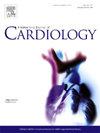桡动脉痉挛预防对乙酰胆碱痉挛激发试验中冠状动脉内血管运动反应的影响。
IF 3.2
2区 医学
Q2 CARDIAC & CARDIOVASCULAR SYSTEMS
引用次数: 0
摘要
背景:经桡动脉入路的侵入性冠状动脉造影通常是在桡动脉痉挛预防(RASP)后进行的。然而,RASP 是否会影响诊断性血管造影术后进行的冠状动脉痉挛激发试验的结果,目前尚不清楚。我们的目的是研究 RASP 对冠状动脉内乙酰胆碱(ACh)测试时血管运动反应的影响:我们回顾性地筛选了 372 名患有心绞痛和冠状动脉无阻塞的连续患者(51% 为女性,平均年龄为 61 ± 11 岁),这些患者按照标准化方案接受了冠状动脉内乙酰胆碱刺激试验。在测试过程中,除了心外膜管腔直径的目测缩小外,还记录了剂量依赖性临床不适和伴随的缺血性心电图变化。在这些患者中,156 人(42%)接受了 RASP(即 200 微克硝酸甘油和 2.5 毫克维拉帕米),而 216 人(58%)没有接受 RASP。两组患者的年龄、性别、心血管风险因素和 ACh 试验结果进行了比较:ACh 激发试验显示,71 例 RASP 患者(46%)和 103 例未用 RASP 患者(48%)出现病理测试结果(p = 0.752)[心外膜痉挛:20 例 RASP 患者(28%)和 42 例未用 RASP 患者(41%)(p = 0.120);微血管痉挛:51 例 RASP 患者(72%)和 61 例未用 RASP 患者(59%)(p = 0.362)]。总体而言,RASP 对冠状动脉血管运动反应无明显改变,无论是冠状动脉痉挛的频率(p = 0.752)或类型(微血管痉挛与心外膜痉挛;p = 0.108),还是导致痉挛的 ACh 剂量(p = 0.151):结论:RASP 不会明显影响冠状动脉血管运动对 ACh 的反应,这表明即使是进行了冠状动脉内痉挛测试的患者也可以常规进行桡动脉痉挛预防。本文章由计算机程序翻译,如有差异,请以英文原文为准。
Effects of radial artery spasm prophylaxis on intracoronary vasomotor responses during acetylcholine spasm provocation testing
Background
Invasive coronary angiography via the radial approach is commonly performed following radial artery spasm prophylaxis (RASP). It is however unknown, whether RASP influences the results of coronary spasm provocation testing performed after diagnostic angiography. We aimed to investigate the effects of RASP on vasomotor responses during intracoronary acetylcholine (ACh) testing.
Methods
We retrospectively screened 372 consecutive patients (51 % female, mean age 61 ± 11 years) with angina and non-obstructive coronary arteries, who underwent intracoronary provocation with ACh according to a standardized protocol. During testing, dose-dependent clinical discomfort and concomitant ischemic electrocardiographic changes were recorded in addition to visual reductions of epicardial lumen diameters. Of these patients, 156 (42 %) received RASP (i.e. 200 μg nitroglycerin and 2.5 mg verapamil), while no RASP was administered in 216 (58 %) patients. Both groups were compared regarding age, sex, cardiovascular risk factors and ACh-test results.
Results
ACh provocation testing revealed a pathological test result in 71 patients (46 %) with RASP and 103 patients (48 %) without (p = 0.752) [epicardial spasm: in 20 patients (28 %) with RASP and 42 patients (41 %) without (p = 0.120); microvascular spasm: in 51 patients (72 %) with RASP and 61 patients (59 %) without (p = 0.362)]. Overall, RASP did not significantly alter coronary artery vasomotor responses, neither regarding the frequency (p = 0.752) or type of coronary spasm (microvascular vs. epicardial; p = 0.108) nor regarding the ACh dose leading to spasm (p = 0.151).
Conclusions
RASP does not significantly affect coronary vasomotor responses to ACh, suggesting that radial artery spasm prophylaxis can be routinely administered even in patients in whom intracoronary spasm testing is performed.
求助全文
通过发布文献求助,成功后即可免费获取论文全文。
去求助
来源期刊

International journal of cardiology
医学-心血管系统
CiteScore
6.80
自引率
5.70%
发文量
758
审稿时长
44 days
期刊介绍:
The International Journal of Cardiology is devoted to cardiology in the broadest sense. Both basic research and clinical papers can be submitted. The journal serves the interest of both practicing clinicians and researchers.
In addition to original papers, we are launching a range of new manuscript types, including Consensus and Position Papers, Systematic Reviews, Meta-analyses, and Short communications. Case reports are no longer acceptable. Controversial techniques, issues on health policy and social medicine are discussed and serve as useful tools for encouraging debate.
 求助内容:
求助内容: 应助结果提醒方式:
应助结果提醒方式:


